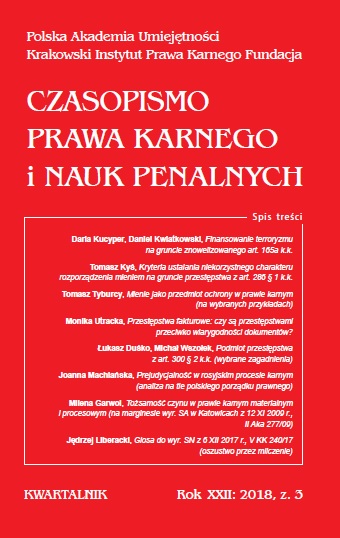Tożsamość czynu w prawie karnym materialnym i procesowym
(na marginesie wyroku Sądu Apelacyjnego w Katowicach z 12 listopada 2009 r., II Aka 277/09)
The identity of the prohibited act in substantial and procedural criminal law (remarks concerning the judgment issued by the Court of Appeal in Katowice on 12 November 2009, II AKa 277/09)
Author(s): Milena GarwolSubject(s): Criminal Law
Published by: Polska Akademia Umiejętności / Krakowski Instytut Prawa Karnego Fundacja
Keywords: social harmfulness of a prohibited act; appeal proceedings; identity of a prohibited act
Summary/Abstract: Przedstawiany komentarz do wcześniej nieomawianego w doktrynie orzeczenia dotyczy problematyki tożsamości czynu w rozumieniu materialnoprawnym i procesowym. Autorka stwierdza, że niemożliwe jest jednoczesne uznanie konkretnej osoby za winną i niewinną popełnienia przestępstwa stanowiącego konsekwencję stosowania zbiegu przepisów. Wniosek taki, postawiony wbrew zasadom logiki, prowadzić winien do uchylenia orzeczenia niezależnie od granic zaskarżenia. W artykule wskazano metody pozwalające orzekającemu organowi na rozwiązywanie tego typu kwestii. Ponadto podkreślono, że społeczna szkodliwość czynu jako materialny aspekt przestępstwa stanowi wtórny przedmiot oceny przestępności czynu i pozostaje bez znaczenia dla treści orzeczenia w razie niespełnienia formalnych przesłanek odpowiedzialności karnej. The commentary concerns the issue of the identity of the prohibited act in substantive and procedural meaning. The main conclusion set forth in this study is that it is not possible to presume that the accused is at the same time guilty and innocent of a crime constructed by applying the institution of the regular concurrence of provisions. Such a conclusion, contrary to the principles of logic, should lead to a reversal of the appealed judgment regardless of the limits of the appeal. The article indicates the possible solutions for resolving this type of conflict. Moreover, it is emphasized that the social harmfulness of a prohibited act constitutes a secondary subject of evaluation and is irrelevant to the content of the judicial decision in the cases of absence of formal aspects of criminal liability.
Journal: Czasopismo Prawa Karnego i Nauk Penalnych
- Issue Year: 22/2018
- Issue No: 3
- Page Range: 163-168
- Page Count: 6
- Language: Polish

